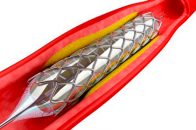Patients with peripheral vascular disease often experience femoropopliteal compromise. It is estimated that approximately 50% of lesions in this area are chronic total occlusions (CTO). Even though success rate has improved for peripheral CTO treatments, long term clinical and technical outcomes have not been fully determined yet. Prior research has looked into stenting outcomes in…
Stent Revascularization in Femoropopliteal Disease: An Analysis of Clustered Randomized Trials
A study compared pooled data of claudication and critical ischemia patients treated with stenting vs. by-pass surgery in femoropopliteal disease. The main objective of revascularization in femoropopliteal disease is to improve the quality of life and functional capacity of claudication patients who did not respond to medical treatment, and to save the affected limb in…
Should We Start Stenting with DES in Femoropopliteal Territory?
Percutaneous intervention of femoropopliteal lesions have been the standard strategy these past two decades. The development of drug eluting stents (DES) or drug eluting balloons (DEB) has improved patency rate compared against conventional balloon angioplasty. The ILLUMINA -a multicenter study- looked into the polymer free self-expanding stent NiTiDES, which showed at 1 year an 87%…
IVUS in Femoropopliteal PCI: Should We Start Using It?
For approximately two decades now, PCI has been the treatment of choice in femoropopliteal territory, and even though technological developments and increasing operator experience have indeed improved outcomes, IVUS (which has showed great benefits in PCI, even reducing left main mortality) is hardly used in this territory. This was a prospective randomized controlled study including…
DES and DCB with Similar Results in Femoropopliteal Artery Disease
Courtesy of Dr. Carlos Fava. Nowadays, peripheral interventions are on the rise and the technological development of stents and balloons would help achieve better outcomes. Both drug-eluting stents (DES) and drug-coated balloons (DCB) have proved to be beneficial for femoropopliteal interventions, but the actual role of each of these technologies remains unclear. This prospective, randomized 1:1…
Latest articles about peripheral vascular diseases
1) Efficacy of Micromesh-Covered Stents in Carotid Artery Stenting Most literature, old and recent, associates carotid artery stenting with a higher rate of stroke (although minor) when compared with carotid endarterectomy during the acute period. However, 30-day outcomes of angioplasty and surgery are comparable. Read more 2) Multivessel Disease and Severe Carotid Stenosis: How to Proceed Myocardial revascularization surgery (CABG) is…
New Strategies for the Femoropopliteal Artery
Courtesy of Dr. Carlos Fava. The incidence of peripheral vascular disease is clearly increasing, progressing towards critical ischemic claudication and amputation. Angioplasty is currently the treatment of choice for these pathologies. Several times, an implanted stent ends up cracking due to extensive calcification, increasing the rate of restenosis and worsening critical ischemia. Technological development on drug-eluting…
Drug-Coated Balloons in Complex Superficial Femoral Artery Lesions
Original Title: Drug-Coated Balloons for Complex Femoropopliteal Lesions2-Year Results of a Real-World Registry. Reference: Andrej Schmidt et al. J Am CollCardiolIntv. 2016;9(7):715-724. The superiority of drug coated balloons compared to conventional balloons in femoropopliteal lesions have been shown by randomized studies, but only in short and simple lesions. The efficacy of drug coated balloons…







